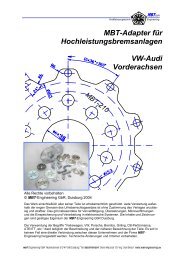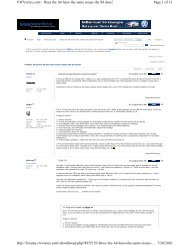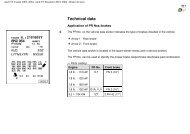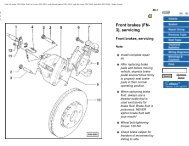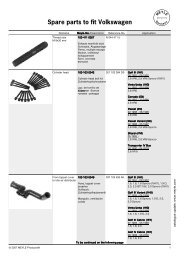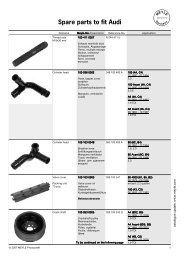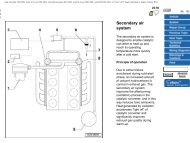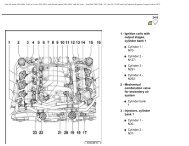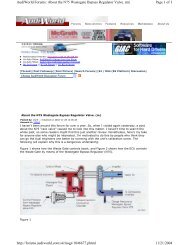VW MKII A2 MK2 Golf Jetta Fox Service Manual - VAGLinks.com
VW MKII A2 MK2 Golf Jetta Fox Service Manual - VAGLinks.com
VW MKII A2 MK2 Golf Jetta Fox Service Manual - VAGLinks.com
You also want an ePaper? Increase the reach of your titles
YUMPU automatically turns print PDFs into web optimized ePapers that Google loves.
9•10 Braking system<br />
Refitting<br />
12 Refitting the master cylinder is a reversal<br />
of the removal procedure. Fit a new mounting<br />
seal between the cylinder and servo unit.<br />
13 On <strong>com</strong>pletion, bleed the brake hydraulic<br />
system.<br />
10 Brake pressure regulator -<br />
testing, removal and refitting 5<br />
1 The regulator is located on the under-body,<br />
in front of the left-hand rear wheel (see<br />
illustration).<br />
2 Checking of the regulator is best left to a<br />
<strong>VW</strong> garage, as special pressure gauges and<br />
spring tensioning tools are required.<br />
3 Adjustment is made by varying the spring<br />
tension. Again, this must be carried out by a<br />
<strong>VW</strong> garage.<br />
4 Removal and refitting are straightforward.<br />
After fitting, bleed the hydraulic system and<br />
have the regulator adjusted by a <strong>VW</strong> garage.<br />
5 When bleeding the hydraulic system of<br />
vehicles fitted with a pressure regulator, the<br />
lever of the regulator should be pressed<br />
toward the rear axle.<br />
11 Hydraulic pipes and hoses -<br />
renewal 3<br />
1 To remove a rigid brake pipe, unscrew the<br />
union nuts at each end and where necessary,<br />
remove the line from its retaining clips.<br />
Refitting is a reversal of removal.<br />
2 To remove a flexible brake hose, unscrew<br />
the union nut securing the rigid brake pipe to<br />
the end of the flexible hose and remove the<br />
spring clip and hose end fitting from the<br />
bracket (see illustration). Unscrew the<br />
remaining end from the <strong>com</strong>ponent or rigid<br />
pipe according to position. Refitting is a<br />
reversal of removal.<br />
3 Bleed the <strong>com</strong>plete hydraulic system after<br />
fitting a brake pipe or hose.<br />
11.2 Rigid pipe-to-flexible hose<br />
connection<br />
10.1 Brake pressure regulator unit<br />
12 Hydraulic system - bleeding<br />
3<br />
Caution: Take great care not to spill brake<br />
fluid onto paintwork as it will act as a paint<br />
stripper. If spilled, wash it off at once with<br />
cold water.<br />
1 Bleeding of the hydraulic system will be<br />
required after any <strong>com</strong>ponent in the system<br />
has been disturbed or any part of the system<br />
“broken”. When an operation has only<br />
affected one circuit of the system, then<br />
bleeding will normally only be required to that<br />
circuit (front and rear diagonally opposite).<br />
2 If the master cylinder or pressure regulating<br />
valve have been disturbed, then the <strong>com</strong>plete<br />
system must be bled. Note that where a brake<br />
pressure regulator is fitted, the regulator lever<br />
should be pressed toward the rear axle during<br />
the bleeding of the rear brakes.<br />
3 One of three methods can be used to bleed<br />
the system.<br />
Two-man method<br />
4 Obtain a clean jar and length of tube which<br />
will fit the bleed valve tightly. The help of an<br />
assistant will be required.<br />
5 Clean around the bleed valve on the rear<br />
brake and attach the bleed tube to the valve<br />
(see illustration)<br />
6 Check that the master cylinder reservoir is<br />
topped up and then destroy the vacuum in the<br />
brake servo (where fitted) by giving several<br />
applications of the brake foot pedal.<br />
12.5 Connect bleed tube to bleed valve<br />
1081 <strong>VW</strong> <strong>Golf</strong> & <strong>Jetta</strong><br />
7 Immerse the open end of the bleed tube in<br />
the jar, which should contain 50 to 76 mm<br />
depth of hydraulic fluid. The jar should be<br />
positioned about 300 mm above the bleed<br />
valve to prevent any possibility of air entering<br />
the system down the threads of the bleed<br />
valve when it is slackened.<br />
8 Open the bleed valve half a turn and have<br />
your assistant depress the brake pedal slowly<br />
to the floor and then quickly remove his foot<br />
to allow the pedal to return unimpeded.<br />
Tighten the bleed valve at the end of each<br />
downstroke to prevent expelled air and fluid<br />
being drawn back into the system.<br />
9 Observe the submerged end of the tube in<br />
the jar. When air bubbles cease to appear,<br />
fully tighten the bleed valve when the pedal is<br />
being held down by your assistant<br />
10 Top-up the fluid reservoir. It must be kept<br />
topped up throughout the bleeding<br />
operations. If the connecting holes in the<br />
master cylinder are exposed at any time due<br />
to low fluid level, then air will be drawn into<br />
the system and work will have to start all over<br />
again.<br />
11 Repeat the operation on the diagonally<br />
opposite front brake.<br />
12 On <strong>com</strong>pletion, remove the bleed tube.<br />
Discard the fluid which has been bled from<br />
the system unless it is required for bleed jar<br />
purposes. Never use it for filling the system.<br />
With one-way valve<br />
13 There are a number of one-man brake<br />
bleeding kits currently available from motor<br />
accessory shops. It is re<strong>com</strong>mended that one<br />
of these kits should be used whenever<br />
possible as they greatly simplify the bleeding<br />
operation and also reduce risk of expelled air<br />
or fluid being drawn back into the system.<br />
14 Connect the outlet tube of the bleeder<br />
device to the bleed valve and then open the<br />
valve half a turn. Depress the brake pedal to<br />
the floor and slowly release it. The one-way<br />
valve in the device will prevent expelled air<br />
from returning to the system at the <strong>com</strong>pletion<br />
of each stroke. Repeat this operation until<br />
clean hydraulic fluid, free from air bubbles,<br />
can be seen <strong>com</strong>ing through the tube. Tighten<br />
the bleed screw and remove the tube.<br />
15 Repeat the procedure on the on the<br />
diagonally opposite brake whilst remembering<br />
to keep the master cylinder reservoir full.<br />
With pressure bleeding kits<br />
16 These are available from motor accessory<br />
shops and are usually operated by air<br />
pressure from the spare tyre.<br />
17 By connecting a pressurised container to<br />
the master cylinder fluid reservoir, bleeding is<br />
then carried out by simply opening each bleed<br />
valve in turn and allowing the fluid to run out<br />
until no air bubbles are visible in the fluid<br />
being expelled.<br />
18 Using this system, the large reserve of<br />
fluid provides a safeguard against air being<br />
drawn into the master cylinder during the<br />
bleeding operations.



